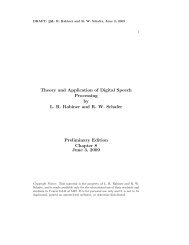Theory and Application of Digital Speech Processing by L. R. ...
Theory and Application of Digital Speech Processing by L. R. ...
Theory and Application of Digital Speech Processing by L. R. ...
You also want an ePaper? Increase the reach of your titles
YUMPU automatically turns print PDFs into web optimized ePapers that Google loves.
DRAFT: L. R. Rabiner <strong>and</strong> R. W. Schafer, June 3, 2009<br />
20 CHAPTER 1. INTRODUCTION TO DIGITAL SPEECH PROCESSING<br />
neural transduction <strong>of</strong> the spectral features into a set <strong>of</strong> sound features (or distinctive<br />
features as they are referred to in the area <strong>of</strong> linguistics) which represent<br />
a fundamental base set <strong>of</strong> sound features that can be decoded <strong>and</strong> processed <strong>by</strong><br />
the brain. The next step in the process is a conversion <strong>of</strong> the sound features<br />
into the set <strong>of</strong> phonemes, words, <strong>and</strong> sentences associated with the in-coming<br />
message <strong>by</strong> a language translation process in the human brain. Finally the last<br />
step in the speech perception model is the conversion <strong>of</strong> the phonemes, words<br />
<strong>and</strong> sentences <strong>of</strong> the message into an underst<strong>and</strong>ing <strong>of</strong> the meaning <strong>of</strong> the basic<br />
message in order to be able to respond to or take some appropriate action. Our<br />
fundamental underst<strong>and</strong>ing <strong>of</strong> the processes in most <strong>of</strong> the speech perception<br />
modules is rudimentary at best, but it is generally agreed upon that some physical<br />
correlate <strong>of</strong> each <strong>of</strong> the steps in the speech perception model occurs within<br />
the human brain, <strong>and</strong> thus the entire model is useful for thinking about the<br />
processes that occur.<br />
Figure 1.12: The <strong>Speech</strong> Chain–From Idea to <strong>Speech</strong> to Underst<strong>and</strong>ing<br />
It is instructive to show the complete speech chain from the formulation <strong>of</strong><br />
an idea to the creation <strong>of</strong> speech <strong>and</strong> finally to the underst<strong>and</strong>ing <strong>of</strong> the idea<br />
on the part <strong>of</strong> the listener as a complete chain, as shown in Figure 1.12, <strong>and</strong> to<br />
estimate the information rates at various steps in the process. Initially, at the<br />
idea stage, the information is embedded in the text message <strong>and</strong> we have already<br />
shown how to make a crude estimate <strong>of</strong> the information rate <strong>of</strong> a text message.<br />
Assume there are about 32 symbols (letters) in the language (in English there<br />
are 26 letters, but if we include simple punctuation we get a count closer to 32<br />
symbols), <strong>and</strong> that the rate <strong>of</strong> speaking for most people is about 10 symbols per<br />
second (somewhat on the high side, but still acceptable for a crude information<br />
rate estimate). We can estimate the base information rate <strong>of</strong> the text message

















